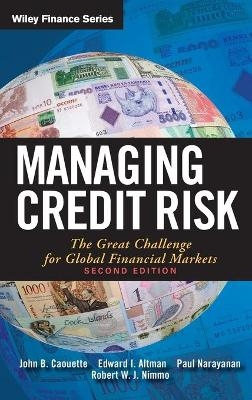
Managing Credit Risk
John Wiley & Sons Inc (Verlag)
978-0-470-11872-6 (ISBN)
Managing Credit Risk, Second Edition opens with a detailed discussion of today’s global credit markets—touching on everything from the emergence of hedge funds as major players to the growing influence of rating agencies. After gaining a firm understanding of these issues, you’ll be introduced to some of the most effective credit risk management tools, techniques, and vehicles currently available. If you need to keep up with the constant changes in the world of credit risk management, this book will show you how.
JOHN B. CAOUETTE is the former vice chairman of MBIA Insurance Corporation and is currently Chairman of Channel Capital Group, a European-based credit derivative products company. EDWARD I. ALTMAN, PHD, MBA, is the Max L. Heine Professor of Finance at the Stern School of Business, New York University. Previously, he chaired the Stern School's MBA Program for twelve years. He has been acclaimed as the world's leading academic on credit risk and distressed and high-yield debt for most of his forty-year career. PAUL NARAYANAN is Director of Credit Portfolio Analytics at American International Group, Inc. He has been involved with credit risk management for more than two decades and in the development and deployment of analytical solutions for credit issues. ROBERT W. J. NIMMO is the former group risk director of Barclays PLC, where he was responsible for all the risk management activities of the group covering credit, market, operational risk, and compliance. He was also the chief risk officer for Wachovia Corporation (20002001) and for Westpac Banking Corporation (19932000).
About the Authors xi
Introduction xv
Chapter 1 Credit Risk: The Great Challenge For The Global Economy 1
Chapter 2 Credit Culture 23
Chapter 3 Classic Industry Players: Banks, Savings Institutions, Insurance: Companies, Finance Companies, and Special Purpose Entities 41
Chapter 4 The Portfolio Managers: Investment Managers, Mutual Funds, Pension Funds, and Hedge Funds 59
Chapter 5 Structural Hubs: Clearinghouses, Derivative Product Companies, and Exchanges 69
Chapter 6 The Rating Agencies 81
Chapter 7 Classic Credit Analysis 103
Chapter 8 Asset-Based Lending and Lease Finance 117
Chapter 9 Introduction to Credit Risk Models 127
Chapter 10 Credit Risk Models Based upon Accounting Data and Market Values 139
Chapter 11 Corporate Credit Risk Models Based on Stock Price 181
Chapter 12 Consumer Finance Models 201
Chapter 13 Credit Models for Small Business, Real Estate, and Financial Institutions 223
Chapter 14 Testing and Implementation of Credit Risk Models 237
Chapter 15 About Corporate Default Rates 251
Chapter 16 Default Recovery Rates and LGD in Credit Risk Modeling and Practice 277
Chapter 17 Credit Risk Migration 311
Chapter 18 Introduction to Portfolio Approaches 325
Chapter 19 Economic Capital and Capital Allocation 349
Chapter 20 Application of Portfolio Approaches 367
Chapter 21 Credit Derivatives 411
Chapter 22 Counterparty Risk 437
Chapter 23 Country Risk Models 455
Chapter 24 Structured Finance 475
Chapter 25 New Markets, New Players, New Ways to Play 509
Chapter 26 Market Chaos and a Reversion to the Mean: The Rediscovery of Culture as a Critical Risk Management Tool 539
Notes 553
Appendix 569
Index 607
| Erscheint lt. Verlag | 6.6.2008 |
|---|---|
| Reihe/Serie | Wiley Finance Editions |
| Zusatzinfo | Screen captures: 89 B&W, 0 Color; Tables: 115 B&W, 0 Color |
| Verlagsort | New York |
| Sprache | englisch |
| Maße | 163 x 236 mm |
| Gewicht | 889 g |
| Themenwelt | Betriebswirtschaft / Management ► Spezielle Betriebswirtschaftslehre ► Bankbetriebslehre |
| ISBN-10 | 0-470-11872-5 / 0470118725 |
| ISBN-13 | 978-0-470-11872-6 / 9780470118726 |
| Zustand | Neuware |
| Haben Sie eine Frage zum Produkt? |
aus dem Bereich


